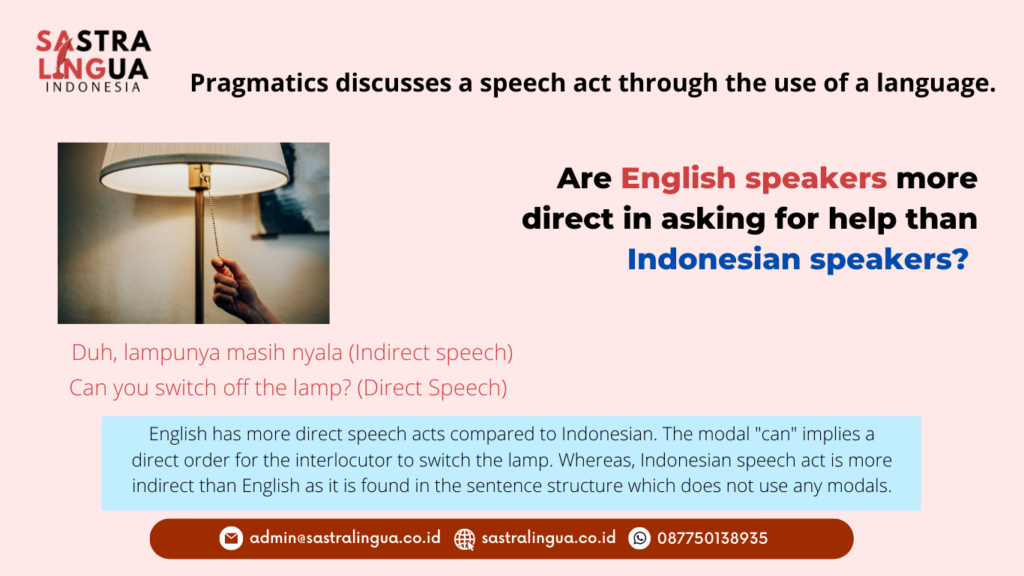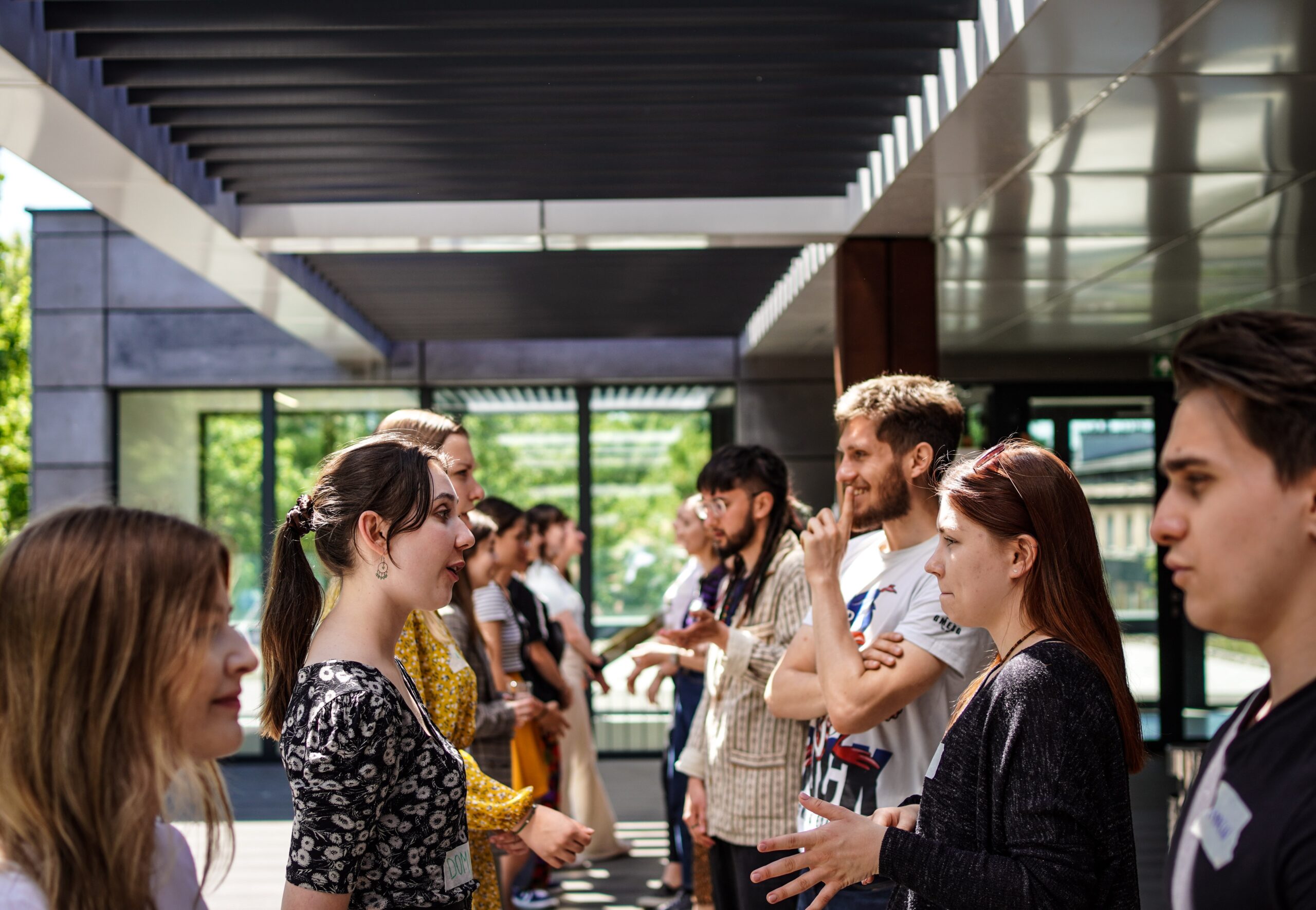In pragmatics, both Indonesian and English are seen from how they are used in communication to deal with the speakers’ intentional or unintentional acts and speech at a particular time and place (Korta & Perry, 2020). Indonesian and English have similar pragmatic functions including direct speech act, indirect speech act, performatives, conversational implicatures such as politeness (Suryoputro, 2017) and rhetoric structure. One example of indirect speech acts that implicates an order in Indonesian and English is in ‘Duh, lampunya masih hidup’ (The lamp is still on!). This sentence in both languages implied that somebody should switch off the lamp. However, in a certain context, this saying could be interpreted differently. Since English is spoken mostly in Western countries where direct meaning is more valued, it requires mostly direct responses. While Indonesian as a language spoken in Asian countries tends to pose indirect speech act. Both Indonesian and English have some particles that could mean differently from what is said according to the context of use (Rofiq, 2018). Indonesian particles despite having different forms may be equivalent to English particles. For example, the particle ‘sih’ in ‘apa sih’ in Indonesian can be used to change a topic as in ‘well’ in English, and it can also have multiple interpretations in certain settings. For example, if somebody who is concentrated on reading says “apa sih?!” with a high tone when his friend tickles him, his saying could mean that his friend’s attitude annoys him.

On the contrary, English and Indonesian have different meanings for their greetings. When one asks ‘Apa kabar?’, she/he expects a longer explanation than ‘Fine. Thank you’ or ‘I am not well.’ It might be related to the cultural context between the communities who speak the languages. As Indonesia is more collectivist and prioritizes long-term relationship orientation, this greeting means a lot and has a deeper intention. While English-speaking countries tend to value short-term relationships, meaning this question is just a warm-up for conversation or just small talk that does not require detailed answers. In addition to the use of particles, English does not have particles to indicate solidarity such as in ya and kan in Indonesian casual conversation.

A language is written in various ways. Both languages use the writing system from Latin script. They both have 26 upper case letters and 26 lower case letters. However, English has 44 phonemes, and 250 graphemes (symbols that represent sounds) in total (Emily, 2019), while Indonesian has only 33 phonemes and 36 graphemes (Yudhistira, 2021). For example, the word ‘kasih’ can be written as ‘love’, use a combination of capital letters and small letters as in ‘Kasih’ and ‘Love’, and be composed of all capital letters as in ‘KASIH’ and ‘LOVE’. The word ‘nyicip’ (taste) will be transcribed as /ɲiĉip/ in Indonesian consisting of five sounds: /ɲ/ /i/ /ĉ/ /i/ /p/ and five graphemes i.e., ny for /ɲ/, i for /i/, c for /ĉ/, i for /i/, and p for /p/ (Sulthan, 2015). English and Indonesian share the same punctuation marks. For example, if one wants to stop or write a new sentence, one should end it with a dot at the end of the previous sentence (Apriyanti et al., 2017).
However, the phoneme /ɲ/ in Indonesian does not exist in English graphemes. In English, the word ‘taste’ has five sounds /t/ /e/ /ɪ/ /s/ /t/ and four graphemes i.e., t for /t/, a for a diphthong /eɪ/, s for /s/, and te for /t/. Since English and Indonesian mostly share the same representational means, it will be easier for learners to understand their writing systems.
In various professional language services, our team will considerably inform readers of the intention of the author accurately. Our team completely understands how the rules of the source language and the target language can correlate with each other. We ensure that our clients get the best quality result as our team works closely on the essential linguistic features of the texts. Are you looking for translators, proofreaders, editors, or linguists? Why not contact us?
Sources
- Korta, K., & Perry, J. (2020). Pragmatics. In E. N. Zalta (Ed.), The Stanford Encyclopedia of Philosophy (Spring 2020). Metaphysics Research Lab, Stanford University. https://plato.stanford.edu/archives/spr2020/entries/pragmatics/
- Rofiq, Z. (2018). The Study of the Indonesian Pragmatic Particle Sih. LiNGUA: Jurnal Ilmu Bahasa Dan Sastra, 13(2), 151. https://doi.org/10.18860/ling.v13i2.8817
- Emily. (2019, August 18). A Phoneme, A Grapheme, A Morpheme: What’s the Difference? The Literacy Nest. https://www.theliteracynest.com/2019/08/a-phoneme-a-grapheme-a-morpheme.html
- Yudhistira. (2021, June 29). Mengenal Grafem: /E/, /ə/, dan e | Narabahasa. https://narabahasa.id/linguistik-umum/fonologi/mengenal-grafem-e-%c9%99-dan
- Sulthan, F. (2015). Grafem | Fonologi | Lingustik. http://rumusindonesia.blogspot.com/2015/05/grafem-fonologi-lingustik.html
- Apriyanti, T., Wulandari, H., Safitri, M., & Dewi, N. (2017). Translating Theory of English into Indonesian and Vice-Versa. Indonesian Journal of English Language Studies (IJELS), 2(1), 22. https://doi.org/10.24071/ijels.v2i1.350

